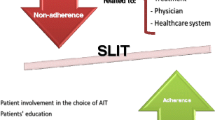Abstract
Background
The sublingual immunotherapy (SLIT) Report Card was developed to capture patient-reported local reactions from the administration of SLIT, based on the World Allergy Organization side-effect grading system. The objective was to evaluate understandability, usability, and translatability of the paper and electronic versions of the SLIT Report Card.
Methods
Adults (aged 18+ years), adolescents (aged 12–17 years), and parents/caregivers and their children (aged 5–11 years) participated in two rounds of interviews, testing the paper version in Round 1, and both the paper and electronic versions in Round 2. Interviews assessed comprehension and usability by subjects. Translatability identified potential issues related to translation or cultural relevance.
Results
Ten adults, ten adolescents, and ten parent/child dyads were interviewed. In general, subjects demonstrated a clear understanding of the instrument’s content. However, some subjects were uncertain of or suggested clarifying the meaning of certain terms, including tablet, ulcer, taste alteration, uvula, nausea, and itching in the ear. The translatability assessment also identified uvula and nausea as potentially problematic for translation. Subjects could use the electronic device and found navigation ‘easy’, with only a few minor suggestions made to improve usability. Some wording and formatting changes were made based on subjects’ feedback and the translatability assessment.
Conclusion
The SLIT Report Card was refined following best practices for instrument development, including cognitive interviewing, usability, and translatability assessment. The refined SLIT Report Card is appropriate for comprehensively and systematically collecting SLIT-related local reactions directly from subjects in a clinical trial setting, taking into account the World Allergy Organization grading system.
Similar content being viewed by others
References
Salo PM, Arbes SJ Jr, Jaramillo R, et al. Prevalence of allergic sensitization in the United States: results from the National Health and Nutrition Examination Survey (NHANES) 2005–2006. J Allergy Clin Immunol. 2014;134(2):350–9.
Passalacqua G. Recommendations for appropriate sublingual immunotherapy clinical trials. World Allergy Organ J. 2014;7(1):21.
Passalacqua G, Baena-Cagnani CE, Bousquet P, et al. Grading local side effects of sublingual immunotherapy for respiratory allergy: speaking the same language. J Allergy Clin Immunol. 2013;32:93–8.
Canonica GW, Cox L, Pawankar R, et al. Sublingual immunotherapy: World Allergy Organization position paper 2013 update. World Allergy Organ J. 2013;7(1):6.
US Food and Drug Administration. Guidance for industry patient-reported outcome measures: use in medical product development to support labeling claims. 2009. http://www.fda.gov/downloads/Drugs/Guidances/UCM193282.pdf. Accessed 30 Jan 2016.
International Society for Pharmacoeconomics and Outcomes Research. Reflection paper on the regulatory guidance for the use of health-related quality of life (HRQL) measures in the evaluation of medical products. 2005. http://www.ispor.org/workpaper/emea-hrql-guidance.pdf. Accessed 30 Jan 2016.
Coons SJ, Gwaltney CJ, Hays RD, et al. Recommendations on evidence needed to support measurement equivalence between electronic and paper-based patient-reported outcome (PRO) measures: ISPOR ePRO Good Research Practices Task Force Report. Value Health. 2009;12:419–29.
Anderson H, Wild D, Gordon-Stables R. Reviewing translatability prior to translation and linguistic validation of PROs. Poster presented at ISPOR, May 18–22, 2013. New Orleans, LA, USA, 2013.
MAXQDA 11. http://www.maxqda.com/products/maxqda11. Accessed 20 Jan 2016.
Martin ML, McCarrier KP, Basse SJ, et al. Using translatability assessment to refine a patient-reported outcome (PRO) measure during the development process. Value Health. 2013;16(3):A63–4.
Blum, SI, Basse, SJ, McCarrier, KP, et al. Assessing the translatability of a new patient reported outcome measure for major depressive disorder. Paper presented at the ISOQOL 20th Annual Conference; Florida; 2013. http://c-path.org/wp-content/uploads/2014/11/assessing-the-translatability-of-a-new-patient-reported-outcome-measure-for-major-depressive-disorder.pdf. Accessed 20 Jan 2016.
Gnanasakthy A, DeMuro C. Logistical considerations for integrating patient-reported outcomes in multi-regional clinical trials. Clin Researcher. 2015;29(2):44–8.
Matza LS, Patrick D, Riley AW, et al. Pediatric patient-reported outcome instruments for research to support medical product labeling: report of the ISPOR PRO good research practices for the assessment of children and adolescents task force. Value Health. 2013;16(4):461–79.
Acknowledgements
We acknowledge the contributions of our following colleagues: Eric Balascio (CRF Health) managed the technical side of the project, including the presentation of the instrument on an electronic device; Barbara Skerritt (ICON) helped with project planning and reviewing of the research questions and documents; and Laura Towns and Adelina Lear (ICON) managed and collated the translatability assessment.
Author information
Authors and Affiliations
Corresponding author
Ethics declarations
Funding
Funding from Merck Sharp & Dohme was obtained by Norquist; administrative, technical, or logistic support was provided by Norquist and Tanzosh.
Conflict of interest
Josephine Norquist, Tiffany Tanzosh, Haojie Li, and Beata Iskold are employees of Merck Sharp & Dohme, who sponsored the study. Emuella Flood, Thelma Rose Ganser, and Helen Marson-Smith were employed by ICON during the study, which was paid by CRFHealth to perform the research.
Ethics approval
All procedures performed in studies involving human participants were in accordance with the ethical standards of the institutional and/or national research committee and with the 1964 Helsinki Declaration and its later amendments or comparable ethical standards.
Consent for publication
Informed consent was obtained from all individual participants included in the study.
Rights and permissions
About this article
Cite this article
Norquist, J., Flood, E., Tanzosh, T. et al. Development of a Report Card for Identifying Local Sublingual Immunotherapy Events in Clinical Trials. Patient 10, 439–446 (2017). https://doi.org/10.1007/s40271-017-0217-0
Published:
Issue Date:
DOI: https://doi.org/10.1007/s40271-017-0217-0




